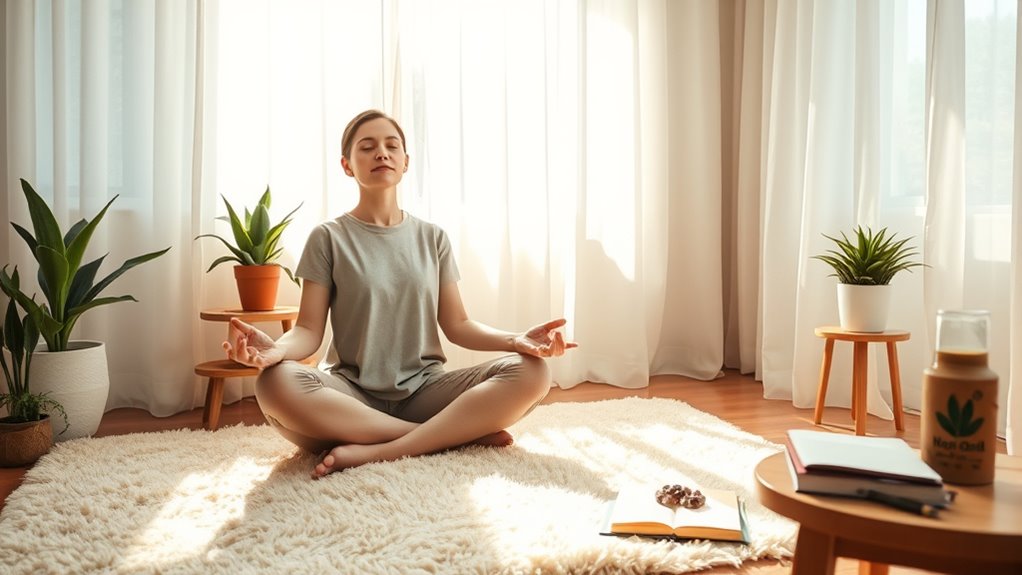To shift smoothly from weekend relaxation to work, try deep breathing exercises like slow, deliberate breaths to calm your nervous system. Incorporate mindful movements or gentle stretches to refresh your body and clear mental clutter. Practice short meditation sessions to center your mind, and use visualization to set positive intentions for the week ahead. Establishing a calming routine can make this shift easier—continue exploring ways to feel more grounded and focused.
Key Takeaways
- Practice mindfulness meditation and deep breathing to reset your mental state and reduce weekend stress.
- Incorporate gentle movement like yoga or stretching to promote physical relaxation and mental clarity.
- Use visualization and positive affirmations to set focused, confident intentions for the upcoming workweek.
- Establish a calming transition routine, such as journaling or aromatherapy, to signal the shift from weekend leisure to work focus.
- Maintain present moment awareness throughout your routine to foster mental clarity, reduce clutter, and cultivate a focused mindset.
Harnessing Deep Breathing to Ease the Shift

Deep breathing can be a simple yet powerful tool to help you shift smoothly from weekend relaxation to the workweek. As you breathe deeply, focus on sensory grounding—notice the feeling of air entering your lungs, the texture of your surroundings, or the sounds nearby. Incorporate mindful journaling by jotting down your sensations and thoughts, anchoring you in the present moment. This practice helps reduce stress and clears your mind, making the transition less abrupt. When you take slow, intentional breaths, you activate your parasympathetic nervous system, promoting calmness. Engaging in mindfulness through unplugging from technology encourages presence and connection with nature. Journaling dreams enhances memory and facilitates interpretation, aiding in personal and spiritual growth. Recognizing the importance of dream recall can help you better understand your subconscious mind and emotional states. Acknowledging the significance of spiritual practices can deepen your sense of grounding and purpose during this transition. Combining deep breathing with sensory grounding and mindful journaling creates a balanced approach, easing mental clutter. This simple routine prepares you mentally and emotionally for the busy days ahead, fostering clarity and focus.
Practicing Mindfulness for Mental Clarity
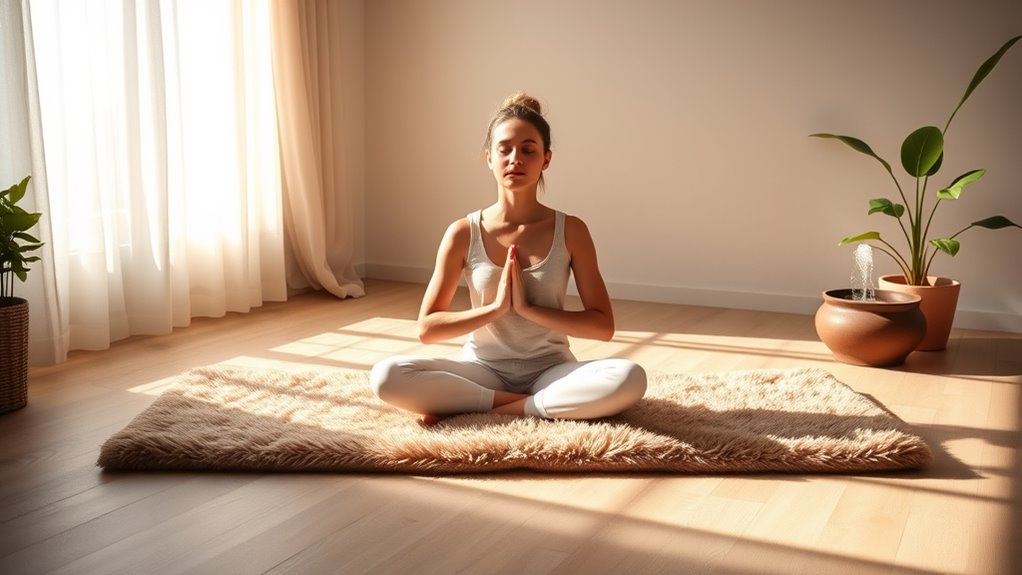
Practicing mindfulness helps you stay focused on the present moment, reducing stress and mental clutter. By cultivating awareness of your thoughts and surroundings, you gain clarity and calmness. Combining this with deep breathing exercises enhances your ability to shift smoothly from weekend relaxation to work mode. Additionally, incorporating automation technology can streamline your daily routines, freeing up mental space for focus and relaxation. For example, understanding the importance of contrast ratio in projectors can help you select the right equipment for your home cinema, which can be a relaxing way to transition into work mode after the weekend. Embracing practical tools grounded in evidence-based insights ensures a sustainable transition between your personal and professional life. Moreover, being aware of recent AI discoveries can inspire innovative approaches to managing your workflow and personal productivity.
Cultivating Present Moment Awareness
To shift smoothly from weekend relaxation to workweek focus, cultivating present moment awareness can be incredibly effective. You can start by practicing mindfulness breathing, which anchors your attention to the present. Take a few slow, deep breaths, focusing on the sensation of air entering and leaving your body. As you breathe, notice your surroundings—the sounds, smells, and sensations—without judgment. This helps you stay rooted in the present moment, rather than lingering on past leisure or future work worries. When you intentionally bring your awareness back to the here and now, you clear mental clutter and gain clarity. Regularly practicing this mindfulness cultivates a calm, focused mindset, making the transition from weekend relaxation to work mode smoother and more intentional. Understanding aura dynamics can also enhance your awareness of subtle emotional shifts, helping you stay balanced during this transition. Incorporating present moment awareness into your daily routine further reinforces this mental clarity and emotional stability. Engaging in mindfulness techniques can deepen your ability to remain centered and focused throughout the day.
Deep Breathing Exercises
When you want to clear mental clutter and achieve greater focus, engaging in deep breathing exercises can be highly effective. By practicing breathing awareness, you tune into each inhale and exhale, grounding yourself in the present moment. These relaxation techniques help calm your nervous system, reducing stress and anxiety that may linger after the weekend. To begin, sit comfortably and take slow, deliberate breaths, noticing the rise and fall of your chest. Focus solely on your breath, letting go of distracting thoughts. Repeating this process for a few minutes can restore mental clarity and boost your concentration. Incorporating deep breathing exercises into your daily routine creates a simple yet powerful way to shift smoothly from weekend relaxation to work readiness. Additionally, aligning your breathing with mindfulness practices can further enhance mental clarity and emotional well-being. Practicing these techniques regularly can also mitigate signs of remote work burnout, helping you maintain motivation and balance. Deep breathing can also support stress reduction by lowering cortisol levels and promoting a sense of calm. Developing a consistent breathing routine can further improve your overall mental resilience, making it easier to handle daily challenges.
Gentle Stretching Routines to Refresh Your Body
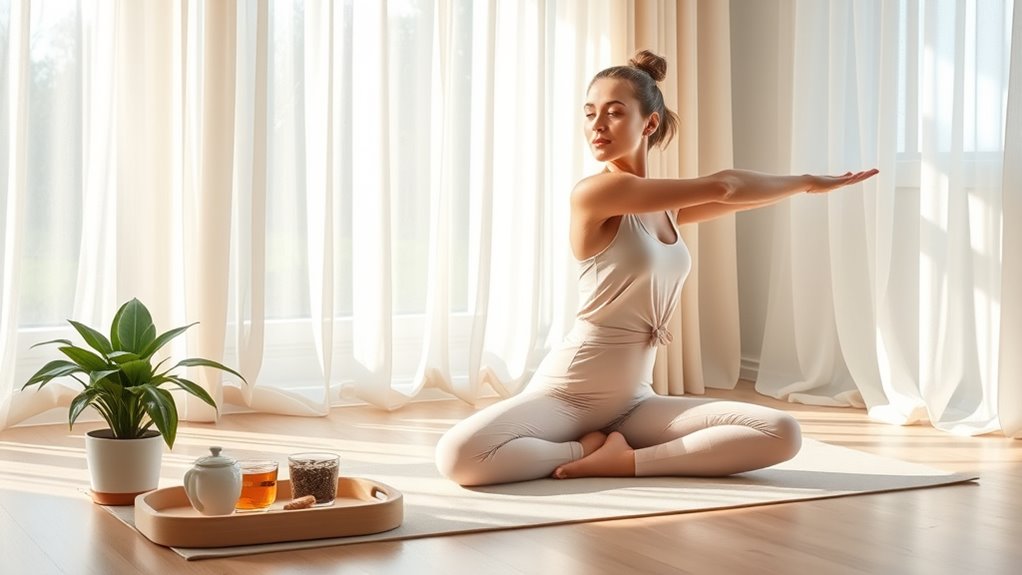
Starting your day with gentle stretching can considerably boost your energy and reduce stiffness after a weekend of relaxation. Incorporate simple yoga poses like cat-cow, downward dog, and gentle spinal twists to awaken your muscles. These movements improve circulation and flexibility, helping you feel more alert. To enhance your routine, add aromatherapy scents such as lavender or peppermint, which can promote relaxation and focus. As you move through each stretch, take deep breaths, syncing your breath with your movements for added calming effects. Keep your stretches slow and mindful, avoiding any strain. This routine refreshes your body, clears your mind, and prepares you for a productive day ahead. Regular gentle stretching sets a positive tone, easing your progression from weekend leisure to work focus. Incorporating mind-body techniques, such as deep breathing or meditation, can further enhance your transition. Creating a calm environment by dimming the lights or playing soft music can also support your relaxation.
Incorporating Short Meditation Sessions Into Your Day
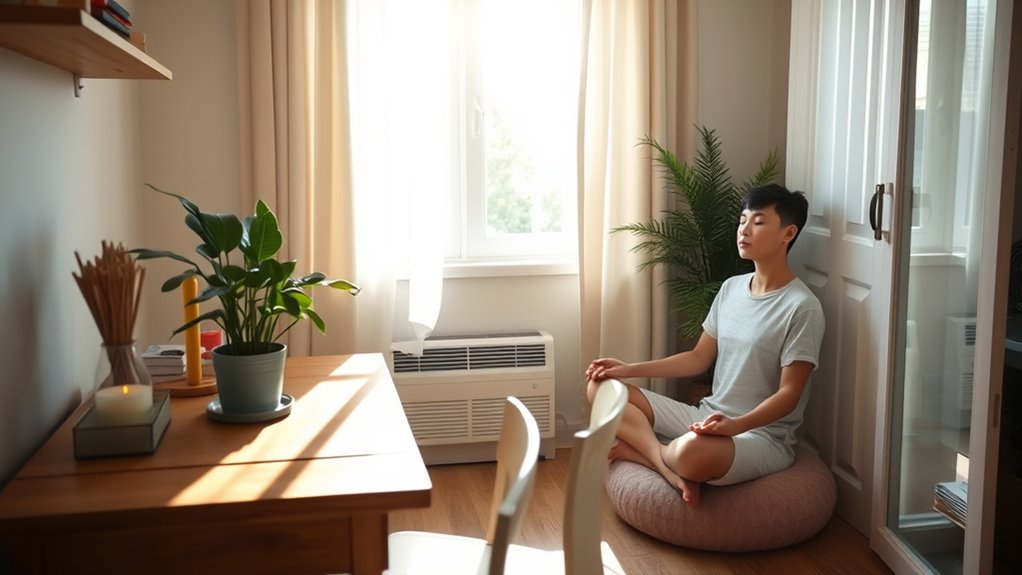
Integrating short meditation sessions into your day can markedly reduce stress and improve focus, making the shift from weekend relaxation to weekday productivity smoother. During breaks, take five to ten minutes to breathe deeply and center yourself. These quick sessions serve as effective post work relaxation, helping you unwind and release tension accumulated during the day. Additionally, incorporating afternoon energizers with meditation can boost your alertness and clarity, preventing fatigue and mental fog. Find a quiet space, close your eyes, and focus on your breath or a calming mantra. Regular practice makes it easier to transition mentally from leisure to work mode, resetting your mind and body. Mindfulness techniques are simple yet powerful tools that can enhance your overall well-being. Practicing progressive relaxation can further deepen your sense of calm and bodily awareness, supporting a smoother transition. Short meditation sessions are accessible, straightforward, and highly beneficial for maintaining balance throughout your busy schedule.
Using Visualization to Set Positive Intentions
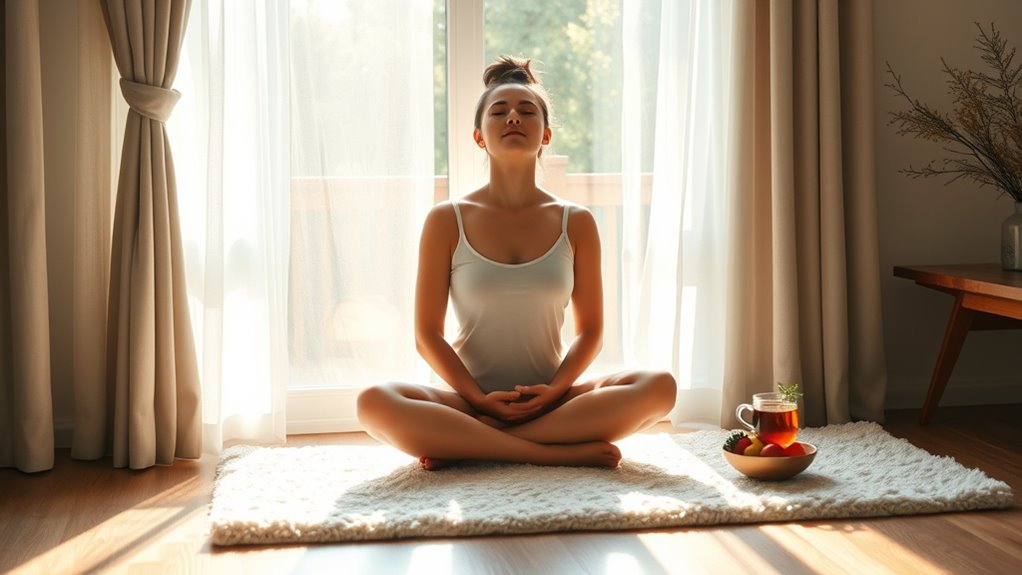
Start your week by imagining your success clearly and confidently. Affirm positive outcomes to reinforce your intentions and boost motivation. Visualize yourself staying calm and focused, setting a strong tone for the days ahead. Incorporating emotional expression through visualization can deepen your connection to your goals and enhance your overall mindset. Engaging in these visualizations can also help you harness mental clarity to better navigate challenges throughout your workweek. Remember, powerful words and inspiring quotes can serve as additional motivational tools to support your journey. As many visionaries emphasize, self-reflection and growth through inspiring images and words can amplify your ability to pursue meaningful progress.
Imagine Your Success
Have you ever wondered how visualizing success can help you set a positive tone for the week ahead? When you imagine yourself achieving your goals, you reinforce your confidence and motivation. Use goal visualization to picture specific moments of success, feeling the satisfaction and pride that come with them. Incorporate positive affirmations into your mental images, such as “I am capable,” or “I handle challenges with ease.” This practice aligns your mindset with your intentions, making success feel more attainable. As you close your eyes and visualize your accomplishments, you create mental pathways that support your efforts. mental imagery can enhance your ability to stay focused and resilient throughout your week, especially when combined with stress management techniques that help maintain your mental clarity. Practicing goal setting regularly can further strengthen your mindset and set you up for sustained success.
Affirm Positive Outcomes
Building on your success visualization, affirming positive outcomes can amplify your mindset and set a clear, optimistic intention for the week. Use positive affirmations to reinforce your confidence and focus on what you want to achieve. Repeating statements like “I am capable of handling challenges” or “I welcome success and growth” helps rewire your thinking toward positivity. Incorporate gratitude journaling into your routine by reflecting on the things you’re thankful for, which boosts your overall sense of well-being and optimism. Recognizing gaslighting tactics and understanding narcissistic behaviors can also strengthen your resilience against emotional manipulation. These practices help anchor your mindset in positivity, making it easier to face the week with enthusiasm and resilience. Engaging in mindfulness techniques can further enhance your emotional clarity and stress management. Affirming positive outcomes creates a powerful foundation for a productive, joyful start to your workweek.
Visualize Calm Focus
When you take a moment to visualize calm focus, you actively set a positive tone for your day ahead. This practice helps you anchor yourself through sensory grounding, bringing awareness to your surroundings, breath, or body sensations. To deepen this focus, consider incorporating mindful journaling afterward, jotting down your intentions or feelings to reinforce clarity. Here are three ways to enhance your visualization:
- Picture yourself confidently tackling tasks with ease.
- Use sensory grounding by focusing on sounds, smells, or textures around you.
- Visualize a calm, focused state flowing through your mind and body, setting a clear and positive intention for the workday.
This combination of visualization, mindful journaling, and sensory grounding helps you segue smoothly from weekend relaxation to weekday productivity.
Creating a Transition Ritual for a Smooth Mind-Body Reset
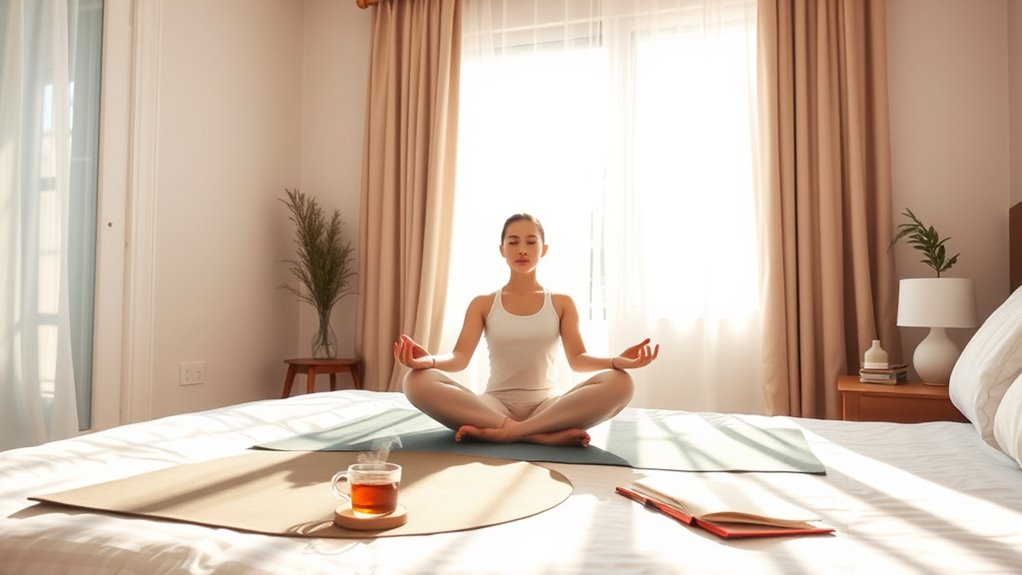
To shift smoothly from weekend relaxation to weekday productivity, establishing a dedicated transition ritual can make a significant difference. Focus on ritual design by creating a simple routine that signals your mind and body to switch gears. This might include a brief mindfulness meditation, stretching, or deep breathing exercises, all aimed at realigning your energy. As you engage in this ritual, consciously focus on energy alignment—letting go of weekend stress and embracing a fresh mindset for work. Keep it consistent each day, so your mind associates this routine with a clear transition. Over time, this ritual becomes a powerful tool to reset your focus, boost energy, and set a positive tone for the week ahead.
Frequently Asked Questions
How Long Should Each Technique Ideally Take to Be Effective?
For each technique, the duration estimates depend on your consistency and the method itself. Typically, you might see effects within 5 to 15 minutes, but some practices, like meditation, may require 20 minutes or more for full benefits. The effectiveness timeline varies, so regular practice helps reinforce stress relief. Start with short sessions and gradually extend them to experience lasting positive impacts on your shift from weekend to work.
Can These Techniques Be Combined for Better Results?
You might wonder if combining techniques offers better results. The answer is yes, because of combination benefits and technique synergy. When you blend practices like deep breathing with gentle stretching or mindfulness, you activate different mind-body pathways, enhancing relaxation and focus. This synergy helps you shift more smoothly, reducing stress and boosting your readiness for work. Just make certain each technique complements the others for maximum effectiveness.
Are There Specific Times of Day Best Suited for These Practices?
Ever wonder when your mind is most receptive to change? Morning routines and evening rituals are ideal for practicing mind-body techniques. Mornings set a calm tone for the day, helping you shift smoothly, while evenings help you unwind and reflect. By incorporating these practices at specific times, you maximize their benefits, making your transition from weekend to work seamless and more balanced.
How Quickly Can I Expect to Notice Mental and Physical Improvements?
You might notice mental and physical improvements within a few days of practicing mindfulness meditation and breathing exercises regularly. Consistent use helps reduce stress, boost focus, and improve overall well-being. While some benefits appear quickly, deeper changes like increased resilience and emotional balance develop over a few weeks. Keep practicing daily, and you’ll likely see positive shifts in your mood, energy, and clarity in just a short time.
Do These Techniques Work Equally Well for Everyone?
Did you know that personalized approaches increase the effectiveness of wellness techniques by up to 70%? When it comes to mind-body methods, they don’t work equally well for everyone because personalization plays a key role. Your unique needs, habits, and stress levels influence results. So, while some may see quick benefits, others might need to adapt techniques to find what works best, ensuring a more effective shift from weekend to work.
Conclusion
By embracing these mind-body techniques, you’ll transform the daunting Monday morning into a fresh start that feels as effortless as a gentle breeze. Each small step, from deep breaths to visualization, acts like a powerful reset button, turning chaos into calm. Remember, your mindset is the compass that can steer your week toward success and serenity—so take charge and make your progression smoother than ever. Your best week yet starts now.
